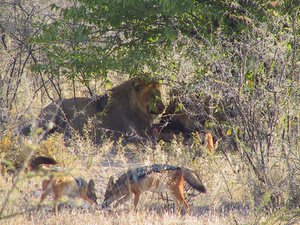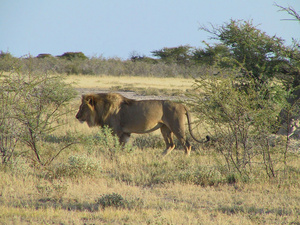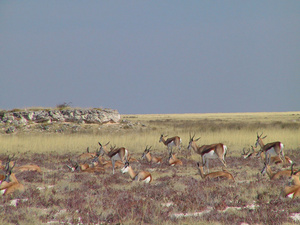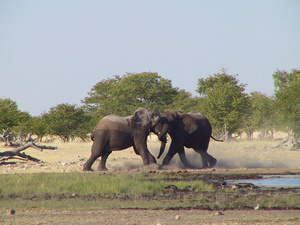Henk Dop: Namibia Trip Report 2005
Halali, Kalkheuwel, Rietfontein, Salvadora, Moringa, Lions
Sunday, 15 May: Namutoni - Halali; 169 km
Monday 16 May: Halali; 106 km
Tuesday 17 May: Halali; 130 km
The campsite was quite busy last night, and with chances of more early risers thus increasing, I set the alarm further back. We're third in line at the gate, a score as good as most of our previous Namutoni mornings. We'll go and spend some time at Kalkheuwel first before coffee at camp, and then break up and head for Halali. Near the spot of the presumed Hyena den, an adult and a young Hyena approach the right side of the road, clearly intent on crossing it. I block their way with the car, we all try to get a few shots, the sun's still very low but there's just enough light. The adult manages to cross, but I succeed in continuing to block the youngster's way with small jerky advances, left hand on the wheel, camera in the right hand. OK, so one is not really supposed to do this - but am I harassing the youngster of just teaching him that cars can, and should be, simply ignored? Probably the latter - because that is indeed what he eventually does. Coming to the site where Marike spotted the Lion and the Zebra carcass (that was yesterday), we find it again without difficulty: two male Lions are now hanging around, the carcass is in a fairly advanced state of dismantlement. A few Jackals are busy getting their bit of the meal, the Lions are largely ignoring them and they succeed in biting off nice little morsels.
Then one of the Lions get up and start to walk away, parallel to the road. We decide to follow him, trying to get a shot every time he passes a small clearing. This goes on for nearly a km, he comes to the large clearing opposite the Kalkheuwel turn-off, and we now see where he's heading for: the rest of the pride, a dozen or so, lying around in the shade some 150 m off the road to our right. As they are now all doing what Lions do best (i.e. nothing) we head for Kalkheuwel.
Once again, we have pole position. There's not really much action yet, but the Ovambo Sparrowhawk coming to drink is quite nice. Another car parks at right angles to ours, an elderly Defender 110, it carries a sign with the MET (Ministry of Environment and Tourism) logo saying 'Official photographer' and another one saying 'Filming vehicle, do not follow'. In it are a long-haired man in his early forties and another man who might possibly be his father.
We all have our windows open and can hear each others’ conversation, and from listening to theirs it's clear that they are certainly experienced. 'Father' may be handling a tiny little digital camcorder, but 'son' steadies some impressive gear on the dashboard, the front window having been lowered. They are clearly intent on doing the same thing we're doing: sit around and see what may happen.
A Pale Chanting Goshawk seems to be the cause of some panic among a flock of Grey Louries sitting in a tree opposite us at the far end of the waterhole. They fly off into a tree behind us, and also catch the attention of the 'official photographer'. The noise the Louries are making is quite spectacular and unlike anything we've ever heard them make before, they're clearly in an advanced state of agitation, we all seem to be wondering whether a mere Goshawk could have caused this.
I then look out over the waterhole again, and note a small figure darting through the grass with something fairly big and grey in its mouth: an African Wildcat with a prey! Marike also notes it, I alert the other car: 'Did you spot the Wildcat, almost straight in front?'. They look, and each get a brief glimpse of it before the cat disappears into the bushes. We receive their thanks for alerting them, and strike up a conversation.
It turns out that they had actually seen a Wildcat catching a Lizard earlier in the morning, then ask if we've seen the Lions. I tell them about how Marike was amazingly actually to first to spot their kill, 'son' in return recounts how he once sat at Kalkheuwel in the company of five other cars, and he was the only one who had spotted a Leopard in plain view, with onlooking Giraffe actually pointing at the Leopard with their cautious gazes. The others seemed simply incapable of doing any serious spotting. Perhaps difficult to imagine, but just this very morning we had also seen people completely miss the Lions when they were in absolutely plain view.
I ask about the 'official photographer' sign, and this is indeed what he is. Has been working with Namibia Wildlife for some 20 years, 'produces picture books'. And just imagine, here we meet one of those rare people who succeed in making a living from this stuff, and I fail to ask him for his name! Anyway, it was nice meeting him, however briefly, I'm sure we'll spot his portrait on the cover of a coffee-table wildlife book one day, and getting his praise and thanks for spotting the Wildcat did a lot of good to the ego. Then the Eland appear again, and the MD4 goes to work. A laughing remark is passed between the 110's occupants: 'I thought we were supposed to be the official photographers!'
It's crowded around the Lions when we head back to Namutoni, the Jackals have now stripped the carcass clean to a mere skeleton. We have coffee and breakfast, break up camp, and proceed to Halali. On our way there we stop at Goas, just to check if anything is going on around here, for just like Kalkheuwel Goas wasn't much in use last year. Fortunately, Goas' twin waterholes are now busy enough, with a fairly large group of Elephants just finishing their drinking and splashing session.
We arrive at Halali at 1300, the large campsite nearly empty as usual, and pick a spot that has both a bit of shade and working electricity. Setting up the tents in the midday sun is again a very sweaty job, but an hour later we're rested, washed, stocked up and ready to go. At Rietfontein a group of Elephant is just leaving, but at least they're around.
Salvadora is lifeless, its erstwhile resident Yellow Mongoose seem to have permanently left. On the plain towards Sueda we encounter a large group of Springbok, all standing with their butts turned towards the sun, while a lone Jackal tries to find at least some shade in the only larger clump of grass around.
As we return to Rietfontein, a group of three male Elephants approaches, followed a little later by another one. After drinking and bathing, the two largest of the four start to spar a bit, but from rather gentle pushing and shoving this seems to turn into more serious stuff. It seems to go in rounds: after each confrontation they move away from each other, then start sizing each other up again. Rubbing one hind leg with the other seems to mean 'I'm ready for it!', after which they both charge again, ears and trunks flapping about, and they clash into each other with a heavy thud, continuing with a multi-ton wrestling match that throws up huge clouds of grey dust. After several rounds one seems to be the loser, and he wanders off. But then an even larger male approaches, and he returns in his company. We can only speculate: has he found a friend to protect him from receiving a further beating? Or was it all just play after all?
Anyway, the scene quietens down, and now a family group of 13 arrives. There's the usual tense greeting when the matriarch meets the males, these seem very keen on investigating the few really tiny young among the group, but these are nervously surrounded by the females and thus shielded from any possible harmful attention. The sequence that now unfolds is just too wonderful, especially the little ones put up a fine display as they try to imitate the adults as these throw around huge fountains of water and mud.
We leave them at 1700, light is fading and we need to be back at the gate at 1730. As we start preparations for a braai, three SA cars turn up and pick the site right next to us. We're initially none too pleased, as there certainly is enough space at the campsite. However, after they settle in they turn out to be really nice people, and, moreover, potjiekos experts, and we've picked up a few good pointers from them.
Working on the fire, Maarten calls out 'Ratel!' (Afrikaans for Honey Badger), and indeed, a large Ratel is doing the rounds of the camp's garbage bins. He seems wholly unconcerned with anyone's presence, the Maglite's beam with which we follow him clearly no more than a minor annoyance. The Ratel's great strength is evident from the effortless way in which he overturns any promising dustbin, then emptying it of its contents with just one or two sweeps of its claws. We keep our distance, and even though this a clearly a well-adapted camp animal, delight in this rare close-up of this usually so elusive animal.
Against better judgement, we do go to the floodlit Moringa waterhole. Even though we eventually do get to see a Black Rhino and her young, the atmosphere at the crowded waterhole and its uncomfortable seating on rocks that have heated up in the full sun during the day, is stifling as ever.
'Don't make even a single sound' is collectively carried to extremes, as if sitting here were some religious experience of extreme importance - or, as if any of the animals would actually give a damn if you cracked open a can of beer in a normal manner. We return to camp, 'How was it?' our neighbours ask. 'Two Rhino's and the usual oppressive atmosphere' is our reply. They seem to understand that perfectly well - they too are regular visitors to Halali. I'll now continue with some highlights per waterhole.




